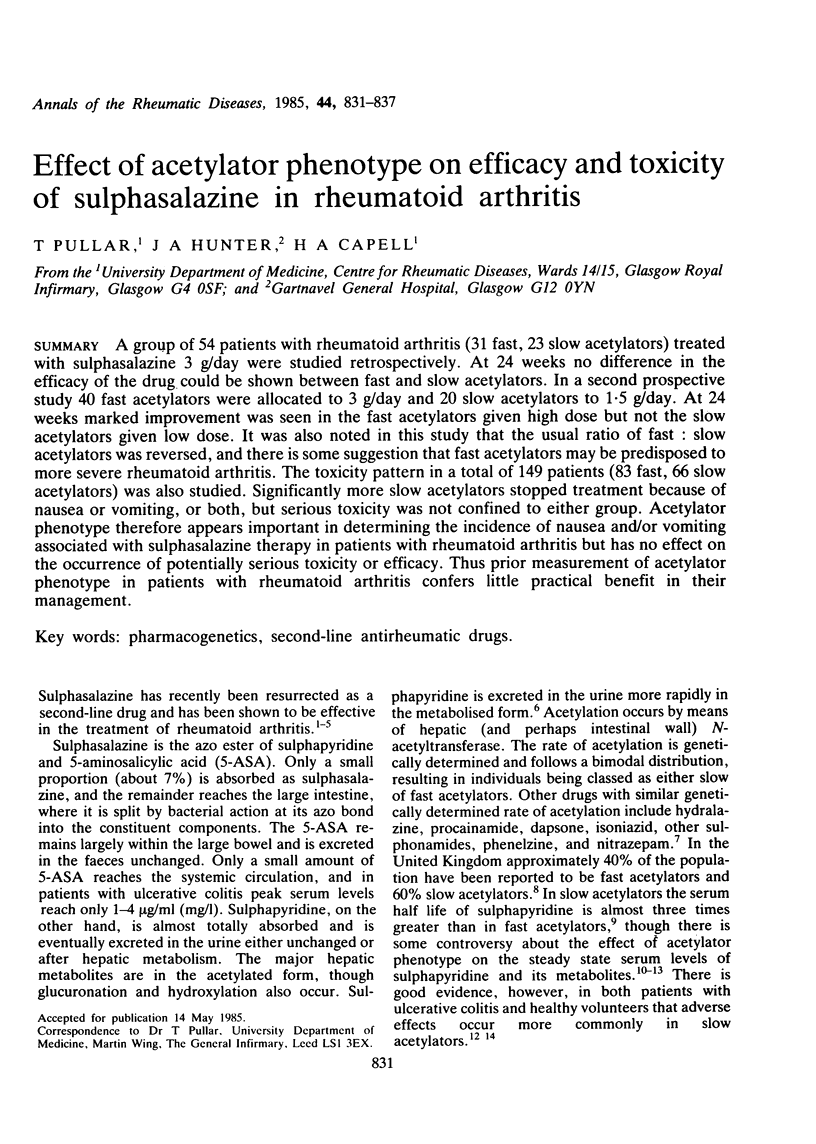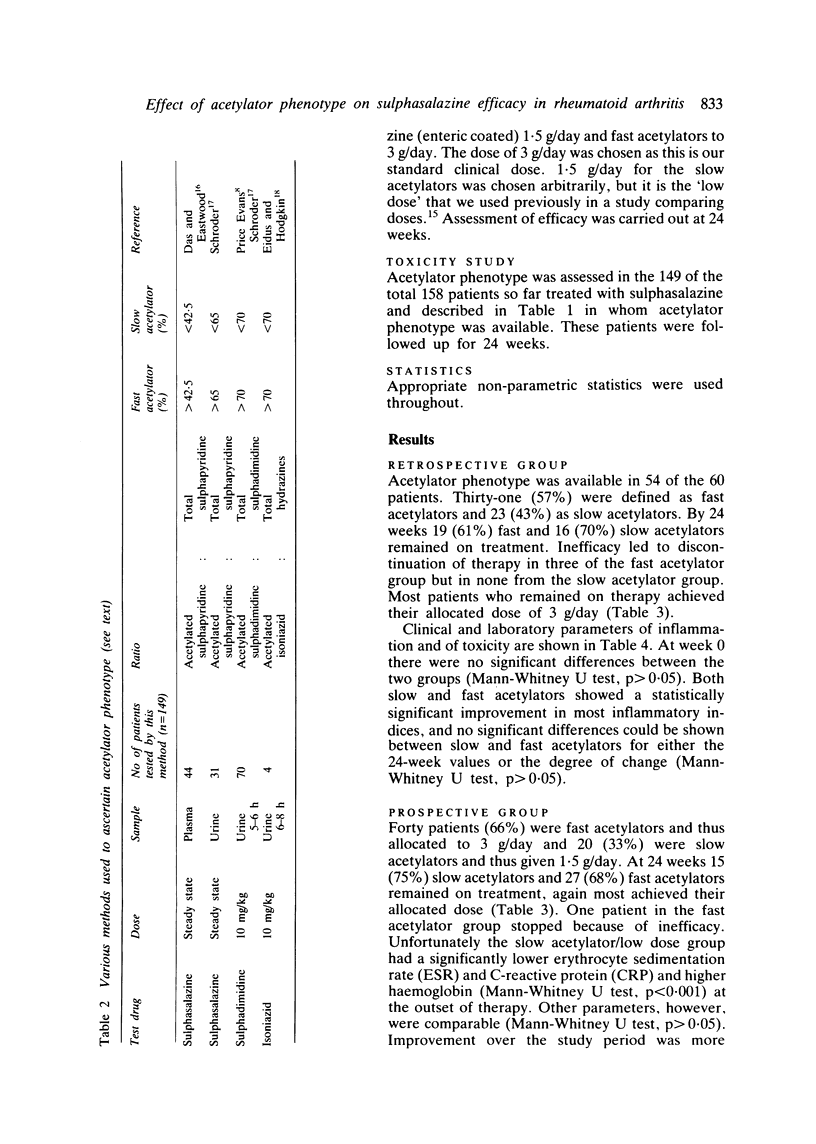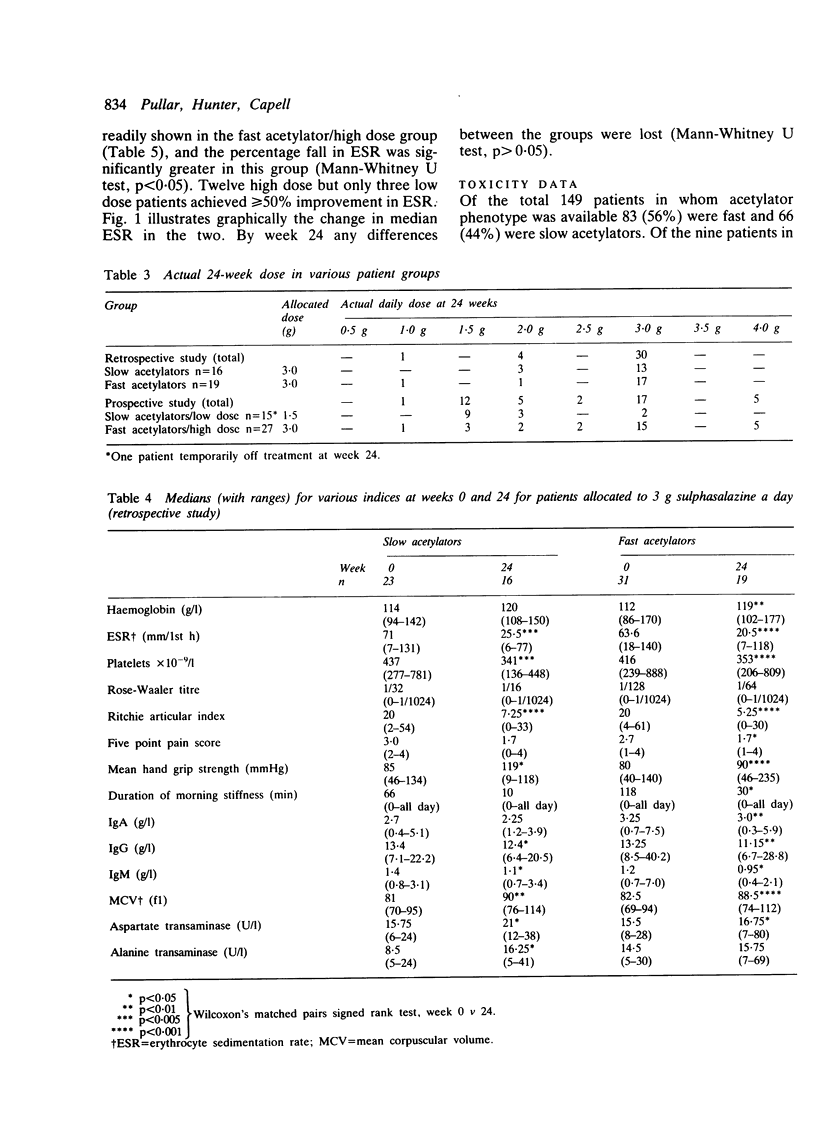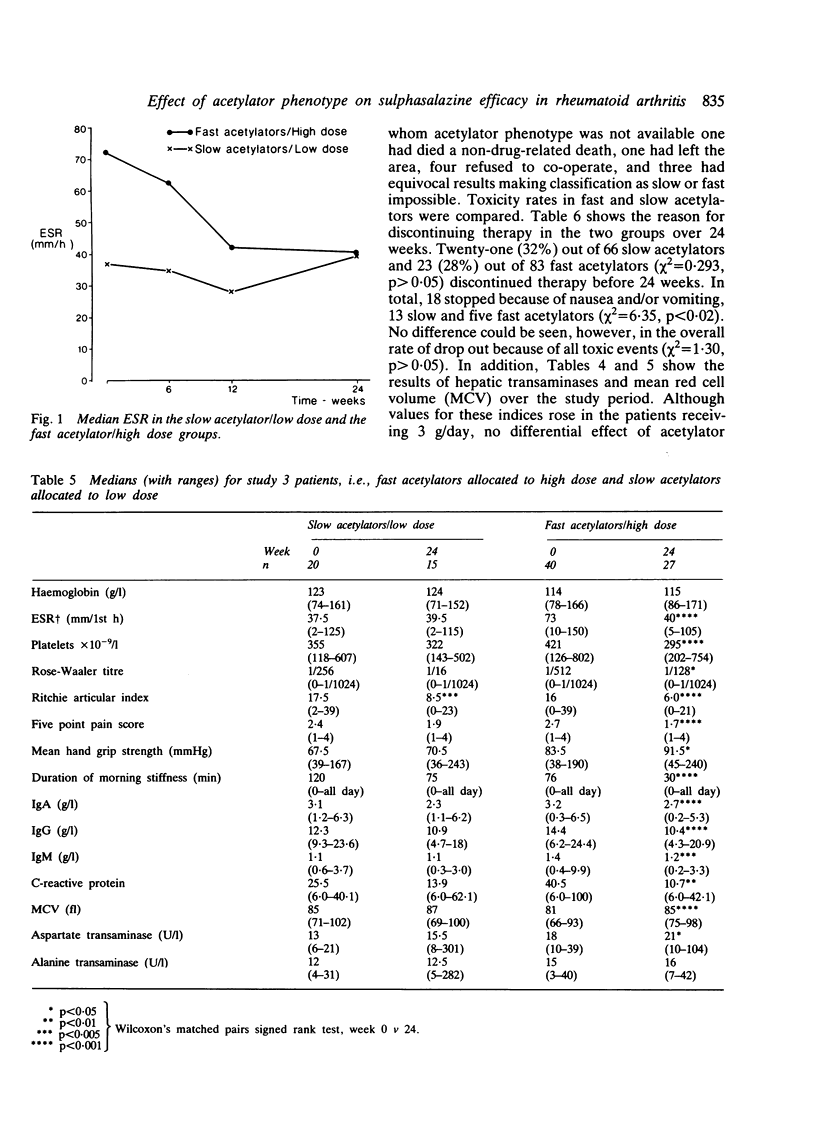Abstract
A group of 54 patients with rheumatoid arthritis (31 fast, 23 slow acetylators) treated with sulphasalazine 3 g/day were studied retrospectively. At 24 weeks no difference in the efficacy of the drug could be shown between fast and slow acetylators. In a second prospective study 40 fast acetylators were allocated to 3 g/day and 20 slow acetylators to 1.5 g/day. At 24 weeks marked improvement was seen in the fast acetylators given high dose but not the slow acetylators given low dose. It was also noted in this study that the usual ratio of fast : slow acetylators was reversed, and there is some suggestion that fast acetylators may be predisposed to more severe rheumatoid arthritis. The toxicity pattern in a total of 149 patients (83 fast, 66 slow acetylators) was also studied. Significantly more slow acetylators stopped treatment because of nausea or vomiting, or both, but serious toxicity was not confined to either group. Acetylator phenotype therefore appears important in determining the incidence of nausea and/or vomiting associated with sulphasalazine therapy in patients with rheumatoid arthritis but has no effect on the occurrence of potentially serious toxicity or efficacy. Thus prior measurement of acetylator phenotype in patients with rheumatoid arthritis confers little practical benefit in their management.
Full text
PDF






Selected References
These references are in PubMed. This may not be the complete list of references from this article.
- Azad Khan A. K., Howes D. T., Piris J., Truelove S. C. Optimum dose of sulphasalazine for maintenance treatment in ulcerative colitis. Gut. 1980 Mar;21(3):232–240. doi: 10.1136/gut.21.3.232. [DOI] [PMC free article] [PubMed] [Google Scholar]
- Azad Khan A. K., Truelove S. C. Circulating levels of sulphasalazine and its metabolites and their relation to the clinical efficacy of the drug in ulcerative colitis. Gut. 1980 Aug;21(8):706–710. doi: 10.1136/gut.21.8.706. [DOI] [PMC free article] [PubMed] [Google Scholar]
- Bird H. A., Dixon J. S., Pickup M. E., Rhind V. M., Lowe J. R., Lee M. R., Wright V. A biochemical assessment of sulphasalazine in rheumatoid arthritis. J Rheumatol. 1982 Jan-Feb;9(1):36–45. [PubMed] [Google Scholar]
- Crook P. R., Hortas C., Roberts E. J., Swinson D. R., Mucklow J. C., Shadforth M. F. Acetylator phenotype and the effect of dapsone in rheumatoid arthritis. J Rheumatol. 1983 Oct;10(5):805–808. [PubMed] [Google Scholar]
- Das K. M., Dubin R. Clinical pharmacokinetics of sulphasalazine. Clin Pharmacokinet. 1976 Nov-Dec;1(6):406–425. doi: 10.2165/00003088-197601060-00002. [DOI] [PubMed] [Google Scholar]
- Das K. M., Eastwood M. A. Acetylation polymorphism of sulfapyridine in patients with ulcerative colitis and Crohn's disease. Clin Pharmacol Ther. 1975 Nov;18(5 Pt 1):514–520. doi: 10.1002/cpt1975185part1514. [DOI] [PubMed] [Google Scholar]
- Das K. M., Eastwood M. A., McManus J. P., Sircus W. Adverse reactions during salicylazosulfapyridine therapy and the relation with drug metabolism and acetylator phenotype. N Engl J Med. 1973 Sep 6;289(10):491–495. doi: 10.1056/NEJM197309062891001. [DOI] [PubMed] [Google Scholar]
- Das K. M., Eastwood M. A., McManus J. P., Sircus W. The metabolism of salicylazosulphapyridine in ulcerative colitis. I. The relationship between metabolites and the response to treatment in inpatients. Gut. 1973 Aug;14(8):631–641. doi: 10.1136/gut.14.8.631. [DOI] [PMC free article] [PubMed] [Google Scholar]
- Eidus L., Hodgkin M. M. Simplified screening test for phenotyping of isoniazid inactivators. Int J Clin Pharmacol. 1973 Feb;7(1):82–86. [PubMed] [Google Scholar]
- Evans D. A. An improved and simplified method of detecting the acetylator phenotype. J Med Genet. 1969 Dec;6(4):405–407. doi: 10.1136/jmg.6.4.405. [DOI] [PMC free article] [PubMed] [Google Scholar]
- Fischer C., Klotz U. Is plasma level monitoring of sulfasalazine indicated in the treatment of Crohn's disease or ulcerative colitis? Ther Drug Monit. 1980;2(2):153–158. doi: 10.1097/00007691-198004000-00009. [DOI] [PubMed] [Google Scholar]
- Lawson D. H., Henry D. A., Lowe J., Reavey P., Rennie J. A., Solomon A. Acetylator phenotype in spontaneous SLE and rheumatoid arthritis. Ann Rheum Dis. 1979 Apr;38(2):171–173. doi: 10.1136/ard.38.2.171. [DOI] [PMC free article] [PubMed] [Google Scholar]
- McConkey B., Amos R. S., Butler E. P., Crockson R. A., Crockson A. P., Walsh L. Salazopyrin in rheumatoid arthritis. Agents Actions. 1978 Jun;8(4):438–441. doi: 10.1007/BF01968673. [DOI] [PubMed] [Google Scholar]
- McConkey B., Amos R. S., Durham S., Forster P. J., Hubball S., Walsh L. Sulphasalazine in rheumatoid arthritis. Br Med J. 1980 Feb 16;280(6212):442–444. doi: 10.1136/bmj.280.6212.442. [DOI] [PMC free article] [PubMed] [Google Scholar]
- Neumann V. C., Grindulis K. A., Hubball S., McConkey B., Wright V. Comparison between penicillamine and sulphasalazine in rheumatoid arthritis: Leeds-Birmingham trial. Br Med J (Clin Res Ed) 1983 Oct 15;287(6399):1099–1102. doi: 10.1136/bmj.287.6399.1099. [DOI] [PMC free article] [PubMed] [Google Scholar]
- Pullar T., Hunter J. A., Capell H. A. Sulphasalazine in rheumatoid arthritis: a double blind comparison of sulphasalazine with placebo and sodium aurothiomalate. Br Med J (Clin Res Ed) 1983 Oct 15;287(6399):1102–1104. doi: 10.1136/bmj.287.6399.1102. [DOI] [PMC free article] [PubMed] [Google Scholar]
- Pullar T., Hunter J. A., Capell H. A. Which component of sulphasalazine is active in rheumatoid arthritis? Br Med J (Clin Res Ed) 1985 May 25;290(6481):1535–1538. doi: 10.1136/bmj.290.6481.1535. [DOI] [PMC free article] [PubMed] [Google Scholar]
- Schröder H., Evans D. A. Acetylator phenotype and adverse effects of sulphasalazine in healthy subjects. Gut. 1972 Apr;13(4):278–284. doi: 10.1136/gut.13.4.278. [DOI] [PMC free article] [PubMed] [Google Scholar]
- Schröder H. Simplified method for determining acetylator phenotype. Br Med J. 1972 Aug 26;3(5825):506–507. doi: 10.1136/bmj.3.5825.506. [DOI] [PMC free article] [PubMed] [Google Scholar]


